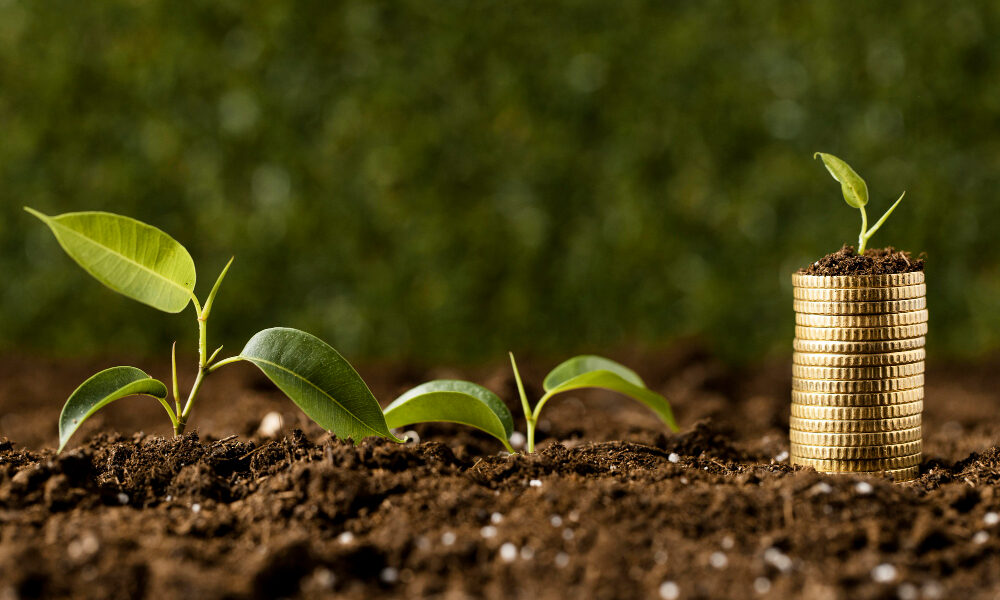
Agriculture Investment
Agriculture: Feeding the Nation and the World
India still depends on agriculture as the backbone of its economy with 30.23 percent of Gross Value Added (GVA) through FY23 and providing food and nutritional security. During Q2 2024-25, the sector experienced its growth at 3.5 percent and India has agricultural exports of $53.1 billion in 2022-23. The government undertakes a task of increasing agri-exports to doubles the US dollars 100 billion targets in the year 2030.
Highlights include:
- Global Export Strength: APEDA manages 51 per cent of the agricultural exports and India is considered one of the foremost organic producers in the global platform.
- Horticultural Boom: It is projected that production in 2023-24 will be 355.25 million tonnes due to the infrastructure and post-harvest management.
- Technology: The e-NAM linking of over 1,260 APMC markets via digital systems has enhanced transparency of prices and income to farmers.
- The Future Is Sustainable: The national missions will encourage natural and climate-resistant farming, where organic goods and more sustainable use of resources will be in the spotlight.
- Government Support: New policies enable the registration of land to a greater extent, digital crops survey, increase in Kisan Credit Cards, and introduction of bioinput centers, to actualize millions of farmers.
- Agricultural Investment: Updating the Pillar of the Economy
Agriculture is the backbone of most economies since it serves as a source of food security, employment, and income to millions. However, with the increase of global challenges (climate change, population growth, scarcity of resources) the industry needs to transform. Agriculture needs strategic investment to be modernized and to be at the same time resilient and capable of long-term prosperity. This is how agriculture projects can revolutionize the business in terms of the adoption of agri-tech, improving the supply chain, financing farmers, and sustainability.
Agri-tech implementation: peak farming, chipper watering, and advanced commerce markets
Precision Farming
Precision farming uses information, sensors, and automation to make every part of the crop production process optimum. Through real time analysis of soil conditions, weather pattern, and crop health, farmers can:
Resort to fertilizers and pesticides in areas only where they are required to save expenses and harm to the environment.
Track the development of crops more precisely, and forecast yields.
Apply drones and satellite mapping to chart fields and detect problems at an earlier stage.
Such site-specific practice results in increased productivity, efficient utilization of resources and in enhanced profitability among farmers.
Smart Irrigation
Lack of water is a significant constraint of agriculture. Smart irrigation systems operate through sensors, weather conditions and automated controls, to provide water exactly at a time when and where crops require it. The major positive impacts involve:
Weighty savings in water-intake-smart irrigation will save up to 30 percent of water usage.
Enhanced agricultural production as plants obtain favorable amounts of water.
Labor and operational costs are reduced since systems automate the monitoring and scheduling.
These systems can be operated by the farmer remotely through mobile applications or a computer, therefore making the irrigation more efficient and adaptive.
Digital Marketplaces
Digitisations bring buyers, suppliers, and service providers in direct contact with farmers. These marketplaces:
Facilitate a transparent price discovery and cut reliance on intermediaries.
Offer up-to-date information on the market, weather conditions and advisory words.
Make it easier to sell the produce, buy the inputs and financial products.
Improvement of Supply Chain: Storage, Transportation and Processing Infrastructures
The storage facilities are modern.
The agricultural productivity and pocket of farmers are hugely diminished by post-harvest losses. Modern solutions in the storage such investments in temperature-controlled silos and warehouses aid:
Maintain the quality and quantity of crops that are harvested.
Minimize waste particularly when dealing with perishable products such as fruits and vegetables.
Allow the farmers to stock products and sell at a good time when the prices are good in the market.
Efficient Transportation
Good transport systems play an important role in transport of farm produce to markets and its processing facilities. Improvements include:
Investing in improvement of roads and railways in the countryside to enhance delivery speed.
Special cars dealing with temperature sensitive goods, maintaining freshness.
Combination of logistic facilities including route tracking and optimization.
Such improvements allow cutting off delays, reducing the cost and delivering food to consumers in an optimum condition.
Agro-Processing Units
Raw agricultural products are a source of revenue and their processing helps add value to them by creating new streams of revenue and avoiding wastages. Examples include:
Sorting, grading, and packaging units.
Plants that manufacture juices, jam, dairy produce, and foods that can be eaten without cooking.
Cold chain systems to ensure the quality as the product is stored and transported.
Processing investments increase incomes to the farmers as well as generating employment in rural areas promoting industrialization in the process.
Farmer Financing: Financial Product Development According to Farmers
Affordable Credit
Most farmers also find it difficult to obtain cheap loans and thus they are limited to purchasing seeds, machinery, or technology. Agricultural customized loans deal with these challenges; they offer:
Reduced interest rates as compared to personal loans.
Flexible terms of repayment synchronised with crop calendar.
Micro-loans to suit the needs of the smallholders.
These products help the farmers make operations more modern, implement new technologies, and deal with the risks more efficiently.
Creative Financial Securities
Apart from regular loans, there is a new set of financial products:
Weather-based insurance to cover crop losses because of bad weather.
Financing of difficult input like supplying of seeds or fertilizers on a credit basis, which is repayable at the end of harvest.
Online credit services to access farm data in determining credit risk and providing immediate approval.
These instruments bring the aspect of finance nearer, newer and relatable to realities of agriculture.
Training and Advice
Education on financial literacy and advisories in the form of education enable farmers to make informed decisions on borrowings and investments. The training programs include:
Documentation and loans applications.
Crops planning and risk management.
Application of digital tools in record-keeping and analysis of the market.
Having a sustained resilient growth and financing are achieved through capacity building.
Sustainable Practices Successful Organic Farming, Soil, and Climate Resiliency
Organic Farming Promotion
Organic farming does not use man-made chemicals, instead, it emphasizes on natural processes and variety. Benefits include:
Increased soil health and fertility via crop rotation, composting and cover cropping.
Increased pest, disease, and climate shock resistance.
Greater market worth and consumer demand of organic produces.
Climate change is also mitigated by the fact that more carbon is sequestered in the soil by organic systems.
Soil Management Health
Production of productive and sustainable agriculture starts with healthy soils. Among the most important practices there are:
Disturbing the soil less by using less tillage.
Presence of ground cover to hold rainwaters and avoid erosion.
Applying a variety of crop rotations and soil-enriching substances to construct soil form and fertility.
Such practices are yield-enhancing, less input-demanding and are viable in the long run.
Good Agricultural Practices
There exist important risks to agriculture because of climate change. Our projects encourage resilience in the following ways:
Promoting drought-tolerant varieties of crops and irrigation using less water.
Agricultural practices such as agro forestry and integrated pest management.
Training about adaptation and climate-smart procedures.
Considering that farmers are exposed to extreme weather and trying to mitigate the impact of this extreme weather we help build resilience which is helping farmers save their livelihoods and therefore ensuring food security.
The wider impact: Building the Economy and the Society
Modernization of the agricultural sector has long-term payoffs:
Economic Development: General econ development is through increased productivity, addition of value and increased jobs in the rural.
Food Security: Effective supply chains and sustainable activities make sure that there is a stable and healthy food supply.
Poverty Reduction: An increase in incomes and access to markets enables the rural family out of poverty.
Environmental Stewardship: Sustainable farming covers the preservation of the natural resources, and biodiversity to be used by other generations.
Investing in modern agriculture is not a matter of increasing yields but it is also a matter of changing the whole ecosystem. Agri-tech adoption, supply chain reinforcement, increased farmer funding and advocacy of sustainable agri-business practices are not only reinforcing a robust, thriving and equitable agricultural ecosystem, but are also fanning the flames of a very promising agricultural future. It is a comprehensive measure that aims to keep the agricultural sector as the locomotive of the economy since it can bring the economy up, promote innovation, and guarantee prosperity to everyone.
Our Approach to Projects
Each project at Seed Finserve is guided by clear principles:
- Client-Centricity: Designing solutions that address the specific needs of our clients.
- Innovation: Embracing new ideas and technologies to deliver better outcomes.
- Sustainability: Ensuring long-term value for clients, communities, and the environment.
- Collaboration: Working with partners, stakeholders, and clients to achieve shared goals.
Impact & Future Vision
Through our diverse portfolio of projects, Seed Finserve continues to drive progress, create opportunities, and build a brighter financial future for all. We measure success not just by financial returns, but by the positive impact we create for clients and communities.
Join us as we turn vision into reality, one project at a time.
Sector Overview
The Agriculture & Allied Sector is the major pillar in the Indian economy and promotes inclusive growth and food security. The past few years have seen a recent surge in developments geared towards improving productivity, sustainability, and livelihood of farmers.
One of the successes is the massive grow of the agricultural exports. Horticulture also appears to be on a steady upward trend as 2023-24 (First Advance Estimates) output of horticulture crops are estimated at 355.25 Mn Tonnes with the cultivated area increasing by 1.15 percent over last year. Furthermore, there is enhanced infrastructure and postharvest management that has contributed to increased yields, which have helped the small farmers and improved food and nutritional security. In a move towards consolidating the industry further, the government revealed its intention to construct huge clusters that will produce vegetables around the key consumption areas.
In 2021-22 alone, an area of 59.12 lakh ha is already under organic farming thereby positioning India as 4 th country in the world in the certified area under organic farming. The transition contributes to the sustainability and health of the soil, and address the emerging demand in the world due to the organic products which creates new market potential. Further, the government in FY 2024-25 budget declared that 1 Cr farmers across the country will be introduced to natural farming and assistance will be provided to certification and branding within two years. Also, 10,000 bioinput resource centers will be set up on the premises of any specialized requirement.
An impressive milestone is the tremendous rise in exportation of agricultural products. India has recorded agricultural exports of $53.1 Bn in the fiscal year 2022-23 and the Agricultural and processed food Products Export development Authority (APEDA) makes up 51 per cent of the same agricultural exports. India has 23 major commodities in the export basket (18 major commodities showed positive growth) as far as April to December 2023 is concerned. Moreover, Agriculture Export Policy (AEP) of India aims at increasing the income of farmers and enhancing the global position of India in agriculture.
India is ambitious and by 2030, it seeks to export agricultural products to the tune of 100 Billion dollars as compared to its current level of around 50 Billion dollars.
Climate resilient agriculture initiatives are of great importance. National Mission for Sustainable Agriculture (NMSA) is one such initiative that is aimed at creating resilient crop varieties and sustainable agricultural methods to address the risk of climate change to achieve long term sustainability of the agricultural practice.
The introduction of technology has revolutionised the industry, with the e-NAM (National Agriculture Market) being one of them. Presently, the site has connected 1,260 APMC mandis in 22 states and 3 union territories that have enabled online trading of 203 agriculture and horticulture commodities. This online program has enhanced transparency in prices and farmers can have direct market access hence increment in income potential.
The government has identified a number of mandated workings in the recently released budget to enhance agricultural system of India. In the subsequent three years, the government expects to deploy Digital Public Infrastructure (DPI) in agriculture to cover more than 6 Cr farmers under the formal land registry system. FY 2024-25 will see a Digital Crop Survey covering 400 districts with the rest to be covered in FY 2025-26. Moreover, in five states, there will be facilitation of issuance of Jan Samarth-based Kisan Credit Cards (KCC) thereby providing farmers with easy access to inputs and credit to agricultural and allied activities thereby ensuring that the agriculture growth drivers of India continue performing better.
To sum up, the agriculture and allied sectors in India are key to economic growth. It also applies the use of technology, sustainability, and diversification to fulfill its domestic requirements as well as create a global competitive market. Such projects hold the potential of boasting huge economic benefits, enhanced food security, and livelihoods for the millions of farmers in the nation, as well as, nutritional security of the billions of consumers across the globe.



